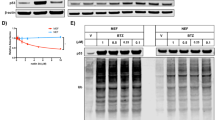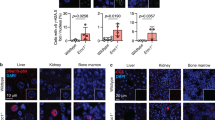Abstract
A tumor suppressor gene, p53, controls cellular responses to a variety of stress conditions, including DNA damage and hypoxia, leading to growth arrest and/or apoptosis. Recently, we demonstrated that in blind subterranean mole rats, Spalax, a model organism for hypoxia tolerance, the p53 DNA-binding domain contains a specific Arg174Lys amino acid substitution. This substitution reduces the p53 effect on the transcription of apoptosis genes (apaf1, puma, pten and noxa) and enhances it on human cell cycle arrest and p53 stabilization/homeostasis genes (mdm2, pten, p21 and cycG). In the current study, we cloned Spalax apaf1 promoter and mdm2 intronic regions containing consensus p53-responsive elements. We compared the Spalax-responsive elements to those of human, mouse and rat and investigated the transcriptional activity of Spalax and human Arg174Lys-mutated p53 on target genes of both species. Spalax and human-mutated p53 lost induction of apaf1 transcription, and increased induction of mdm2 transcription. We conclude that Spalax evolved hypoxia-adaptive mechanisms, analogous to the alterations acquired by cancer cells during tumor development, with a bias against apoptosis while favoring cell arrest and DNA repair.
This is a preview of subscription content, access via your institution
Access options
Subscribe to this journal
Receive 50 print issues and online access
$259.00 per year
only $5.18 per issue
Buy this article
- Purchase on Springer Link
- Instant access to full article PDF
Prices may be subject to local taxes which are calculated during checkout



Similar content being viewed by others
References
Ashur-Fabian O, Avivi A, Trakhtenbrot L, Adamsky K, Cohen M, Kajakaro G et al. (2004). Evolution of p53 in hypoxia-stressed Spalax mimics human tumor mutation. Proc Natl Acad Sci USA 101: 12236–12241.
Avivi A, Ashur-Fabian O, Amariglio N, Nevo E, Rechavi G . (2005a). p53 – a key player in tumoral and evolutionary adaptation: a lesson from the Israeli blind subterranean mole rat. Cell Cycle 4: 368–372.
Avivi A, Resnick MB, Nevo E, Joel A, Levy AP . (1999). Adaptive hypoxic tolerance in the subterranean mole rat Spalax ehrenbergi: the role of vascular endothelial growth factor. FEBS Lett 452: 133–140.
Avivi A, Shams I, Joel A, Lache O, Levy AP, Nevo E . (2005b). Increased blood vessel density provides the mole rat physiological tolerance to its hypoxic subterranean habitat. FASEB J 19: 1314–1316.
el-Deiry WS, Kern SE, Pietenpol JA, Kinzler KW, Vogelstein B . (1992). Definition of a consensus binding site for p53. Nat Genet 1: 45–49.
Gagnebin J, Kovar H, Kajava AV, Estreicher A, Jug G, Monnier P, Iggo R . (1998). Use of transcription reporters with novel p53 binding sites to target tumour cells expressing endogenous or virally transduced p53 mutants with altered sequence-specificity. Oncogene 16: 685–690.
Goda N, Ryan HE, Khadivi B, McNulty W, Rickert RC, Johnson RS . (2003). Hypoxia-inducible factor 1alpha is essential for cell cycle arrest during hypoxia. Mol Cell Biol 23: 359–369.
Graeber TG, Osmanian C, Jacks T, Housman DE, Koch CJ, Lowe SW et al. (1996). Hypoxia-mediated selection of cells with diminished apoptotic potential in solid tumours. Nature 379: 88–91.
Hollstein M, Sidransky D, Vogelstein B, Harris CC . (1991). p53 mutations in human cancers. Science 253: 49–53.
Jubb AM, Pham TQ, Hanby AM, Frantz GD, Peale FV, Wu TD et al. (2004). Expression of vascular endothelial growth factor, hypoxia inducible factor 1alpha, and carbonic anhydrase IX in human tumours. J Clin Pathol 57: 504–512.
Kannan K, Kaminski N, Rechavi G, Jakob-Hirsch J, Amariglio N, Givol D . (2001). DNA microarray analysis of genes involved in p53 mediated apoptosis: activation of Apaf-1. Oncogene 20: 3449–3455.
Kinzler KW, Vogelstein B . (1996). Life (and death) in a malignant tumour. Nature 379: 19–20.
Klein C, Planker E, Diercks T, Kessler H, Kunkele KP, Lang K et al. (2001). NMR spectroscopy reveals the solution dimerization interface of p53 core domains bound to their consensus DNA. J Biol Chem 276: 49020–49027.
Klein G . (2004). Cancer, apoptosis, and nonimmune surveillance. Cell Death Differ 11: 13–17.
Kuramochi H, Hayashi K, Uchida K, Miyakura S, Shimizu D, Vallbohmer D et al. (2006). Vascular endothelial growth factor messenger RNA expression level is preserved in liver metastases compared with corresponding primary colorectal cancer. Clin Cancer Res 12: 29–33.
Levine AJ . (1997). p53, the cellular gatekeeper for growth and division. Cell 88: 323–331.
Liu G, Parant JM, Lang G, Chau P, Chavez-Reyes A, El-Naggar AK et al. (2004). Chromosome stability, in the absence of apoptosis, is critical for suppression of tumorigenesis in Trp53 mutant mice. Nat Genet 36: 63–68.
Moroni MC, Hickman ES, Lazzerini Denchi E, Caprara G, Colli E, Cecconi F et al. (2001). Apaf-1 is a transcriptional target for E2F and p53. Nat Cell Biol 3: 552–558.
Nevo E . (1999). Mosaic Evolution of Subterranean Mammals: Regression, Progression and Global Convergence. Oxford University Press: Oxford.
Nevo E, Ivanitskaya E, Beiles A . (2001). Adaptive Radiation of Blind Subterranean Mole Rats. Backhuys: Leiden.
Oliver FJ, Marvel J, Collins MK, Lopez-Rivas A . (1993). Bcl-2 oncogene protects a bone marrow-derived pre-B-cell line from 5′-fluor,2′-deoxyuridine-induced apoptosis. Biochem Biophys Res Commun 194: 126–132.
Peters KG, De Vries C, Williams LT . (1993). Vascular endothelial growth factor receptor expression during embryogenesis and tissue repair suggests a role in endothelial differentiation and blood vessel growth. Proc Natl Acad Sci USA 90: 8915–8919.
Resnick MA, Inga A . (2003). Functional mutants of the sequence-specific transcription factor p53 and implications for master genes of diversity. Proc Natl Acad Sci USA 100: 9934–9939.
Royds JA, Dower SK, Qwarnstrom EE, Lewis CE . (1998). Response of tumour cells to hypoxia: role of p53 and NFκB. Mol Pathol 51: 55–61.
Rozenfeld-Granot G, Krishnamurthy J, Kannan K, Toren A, Amariglio N, Givol D et al. (2002). A positive feedback mechanism in the transcriptional activation of Apaf-1 by p53 and the coactivator Zac-1. Oncogene 21: 1469–1476.
Ryan KM, Vousden KH . (1998). Characterization of structural p53 mutants which show selective defects in apoptosis but not cell cycle arrest. Mol Cell Biol 18: 3692–3698.
Shams I, Avivi A, Nevo E . (2004). Hypoxic stress tolerance of the blind subterranean mole rat: expression of erythropoietin and hypoxia-inducible factor 1 alpha. Proc Natl Acad Sci USA 101: 9698–9703.
Shams I, Nevo E, Avivi A . (2005a). Erythropoietin receptor spliced forms differentially expressed in blind subterranean mole rats. FASEB J 19: 1749–1751.
Shams I, Nevo E, Avivi A . (2005b). Ontogenetic expression of erythropoietin and hypoxia-inducible factor-1 alpha genes in subterranean blind mole rats. FASEB J 19: 307–309.
Shweiki D, Itin A, Soffer D, Keshet E . (1992). Vascular endothelial growth factor induced by hypoxia may mediate hypoxia-initiated angiogenesis. Nature 359: 843–845.
Vogelstein B, Kinzler KW . (2004). Cancer genes and the pathways they control. Nat Med 10: 789–799.
Vousden KH, Lu X . (2002). Live or let die: the cell's response to p53. Nat Rev Cancer 2: 594–604.
Widmer HR, Hoppeler H, Nevo E, Taylor CR, Weibel ER . (1997). Working underground: respiratory adaptations in the blind mole rat. Proc Natl Acad Sci USA 94: 2062–2067.
Acknowledgements
We appreciate Dr Imad Shams help in this study, and we thank Eti Rosenthal for her technical assistance with the cell cycle experiments. We thank the Ancell Teicher Research Foundation for Genetics and Molecular Evolution for financial support. We also thank the Arison family for their donation to the Center of DNA Chips, Pediatric Oncology, Chaim Sheba Medical Center. GR holds the Djerassi Chair in Oncology at the Sackler School of Medicine.
Author information
Authors and Affiliations
Corresponding author
Rights and permissions
About this article
Cite this article
Avivi, A., Ashur-Fabian, O., Joel, A. et al. P53 in blind subterranean mole rats – loss-of-function versus gain-of-function activities on newly cloned Spalax target genes. Oncogene 26, 2507–2512 (2007). https://doi.org/10.1038/sj.onc.1210045
Received:
Revised:
Accepted:
Published:
Issue Date:
DOI: https://doi.org/10.1038/sj.onc.1210045
Keywords
This article is cited by
-
Hypoxia tolerance, longevity and cancer-resistance in the mole rat Spalax – a liver transcriptomics approach
Scientific Reports (2017)
-
The system capacity view of aging and longevity
Quantitative Biology (2017)
-
Adaptive patterns in the p53 protein sequence of the hypoxia- and cancer-tolerant blind mole rat Spalax
BMC Evolutionary Biology (2016)
-
Genome maintenance and bioenergetics of the long-lived hypoxia-tolerant and cancer-resistant blind mole rat, Spalax: a cross-species analysis of brain transcriptome
Scientific Reports (2016)
-
p53 gene discriminates two ecologically divergent sister species of pine voles
Heredity (2015)



